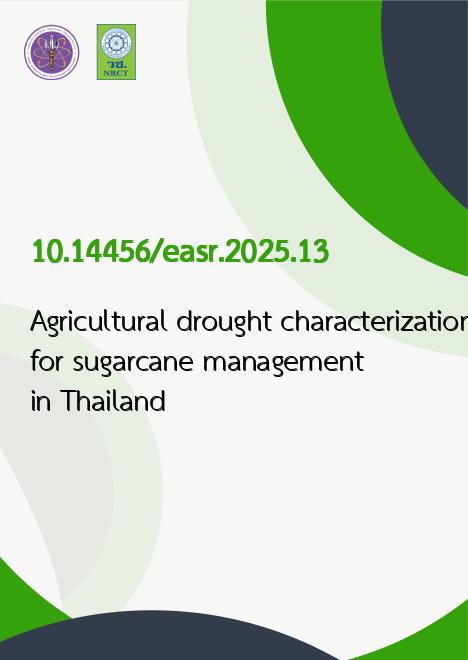
|
Agricultural drought characterization for sugarcane management in Thailand |
|---|---|
| รหัสดีโอไอ | |
| Creator | 1. Piyapong Wongkhunkaew 2. Vichai Sriboonlue 3. Supasit Konyai |
| Title | Agricultural drought characterization for sugarcane management in Thailand |
| Publisher | Faculty of Engineering, Khon Kaen University |
| Publication Year | 2568 |
| Journal Title | Engineering and Applied Science Research |
| Journal Vol. | 52 |
| Journal No. | 2 |
| Page no. | 148-158 |
| Keyword | Drought hazard, Sugarcane, Standardized actual evapotranspiration index, El Nino, Theory of runs |
| URL Website | https://ph01.tci-thaijo.org/index.php/easr/index |
| Website title | Engineering and Applied Science Research |
| ISSN | 2539-6161 |
| Abstract | One of the main factors affecting sugarcane production in Thailand is drought hazard due to reliance on rainfed irrigation. Sugarcane agricultural drought was studied over four regions of dense cane areas from 1990 to 2020 to help inform appropriate policies and practices for mitigating future damages. The research aimed to assess agricultural drought variability of 15 locations throughout the mainland Thailand during the three decades. Actual evapotranspiration (ETa) was used as an indicator and then transformed into the standardized ETa index (SEaI12) over a 12-month timescale, as the sugarcane crop cycle in Thailand is approximately 12 months. For the last decade, the SEaI12 series of each location was correlated with sugarcane yield, sweetness (CCS), and Nino 3.4 resulting in very good, poor, and fair, respectively. All SEaI12 time series were quantified for drought event time series using the run theory. The severity of drought was characterized by duration and deficit, and since they were closely related, only duration was explored. All evaluation processes from ETa to SEaI12 to drought characteristics were cautiously performed in detail. Drought characterizations were demonstrated in two conditions: (i) spatial distribution of the longest drought from each location; (ii) comparison of distribution and frequency of droughts among the three decades. The highest value of the longest drought is located at the highest latitude and decreases towards the lower latitudes. Among the three decades, the 1990s, an El Nino dominated decade, showed highest accumulated drought and frequency values and the 2000s, a La Nina dominated decade, gave the lowest values. |
